by LEONARD FELDMAN
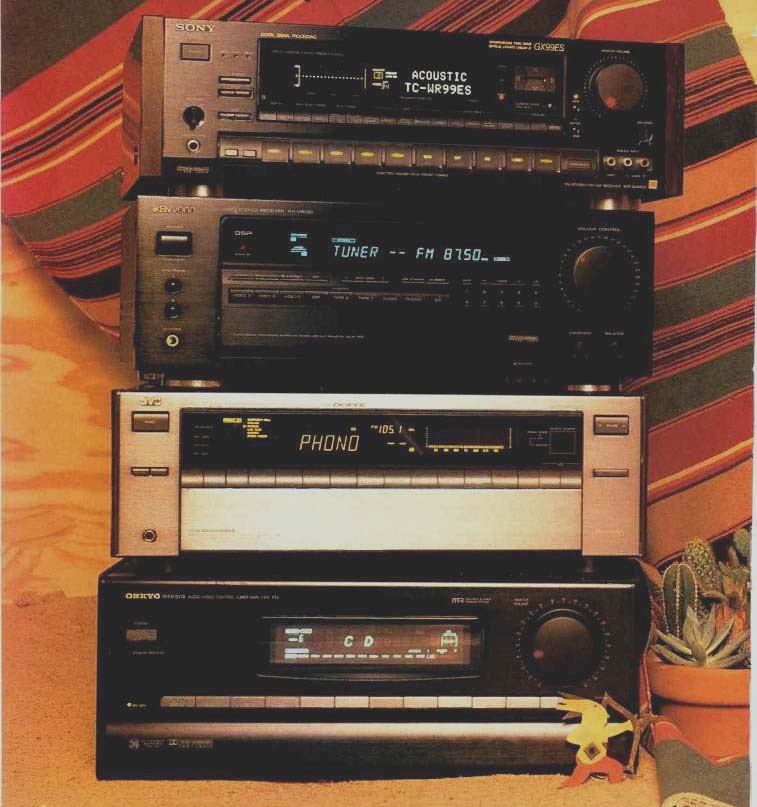
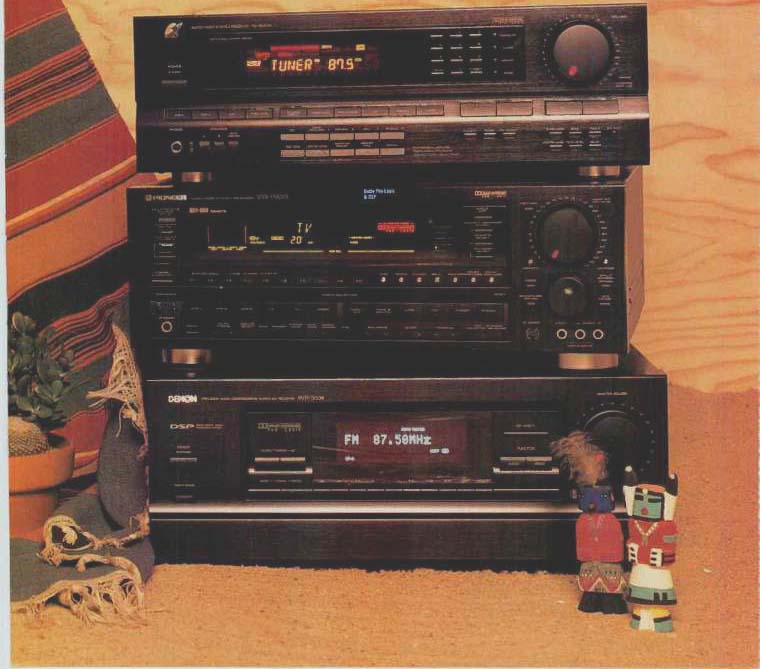
Above (top tp bottom): Receivers from Sony, Kenwood, JVC, and Onkyo, Sansui,
Pioneer, and Denon.
The popularization of home theater audio/video entertainment rooms has boosted the popularity of the receiver. Today's A/V receivers, unlike the stereo tuner/amplifiers of yesteryear, include decoders and extra amplifier channels for surround sound. Most popular models have video as well as audio connections to control the entire A/V system. They also have enough amp channels to power from three to five speakers for home theater use; at least one model of those I reviewed here has seven channels.
The decoders in the seven receivers tested include Dolby Pro-Logic circuitry (at least partially digital, in several cases) that enhances separation between the front, center, and rear (surround) channels. These Pro-Logic decoders all allow deliberately limited adjustment of rear-channel delay and a choice of three front-channel modes: Phantom (for systems without center speakers), normal (for systems whose center speakers have less bass than the main speakers), and wide (for systems whose three front speakers have equal bass capabilities). Most have full-range mono line outputs that can feed a self-powered subwoofer.
Other home theater features found in common include a three-channel Dolby Surround mode for systems without rear speakers and universal remotes that are preprogrammed to control other audio and video components and can learn the commands for still more components. And since these are audio as well as home theater components, all seven have phono inputs.
For all their flexibility and versatility, not all A/V receivers are equal. Therefore, Audio's editor decided to conduct a no-holds-barred comparison test and evaluation. Separate comparison charts are included for the tuner and amplifier sections of each receiver, as well as for the video sections and the convenience features and facilities. Ratings from 0 to 10 are assigned for each of the sections and for overall convenience, and, finally, an overall rating is given to each model. All of the receivers are excellent performers, but some are better than others. In addition, overall ratings are based, in part, on price/ performance ratio. Obviously, a $1,000 receiver that performs as well and has as many useful features as a $1,300 receiver would garner a somewhat higher rating.
DENON AVR-3000
This benchmark unit from Denon has five high-power amplifier channels (110 watts per channel for the front left, center, and right channels; 35 watts per channel for the ear channels). Its analog and digital micro circuits deliver outstanding Dolby Pro-Logic surround sound enhanced by powerful digital signal processing (DSP) capabilities. Operating in parallel with the Pro-Logic circuit y, DSP offers surround environments suit able for music-only listening, such as "Classic," "Jazz," "Church," and many more, Additional A/V modes include "Wide Screen' fa- greater user control of such system parameters as delay when watching movies), "Live" (with default parameters more suited o live musical performances), and "Mono Movie" (a stereo simulation). Surround parameters can be adjusted to achieve desired effects.
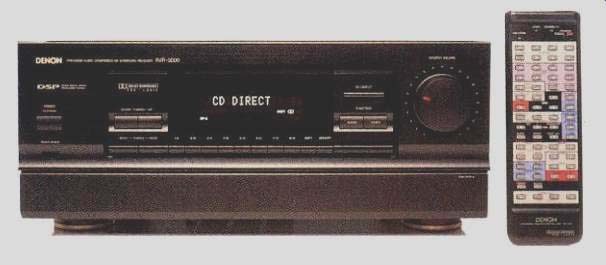
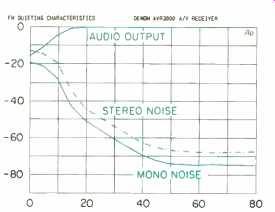
above: FM quieting characteristics Denon AVR-3000.
The Denon's measured FM tuner performance was certainly adequate but not as good as I might have hoped insofar as us able sensitivity and ultimate signal-to-noise Channel separation, on the other hand, was fairly good, and tuning was accurate and stable. Activating and setting up the 16 AM/FM station presets was relatively simple, and I liked the fact that the less-often-used controls were hidden behind a swing-down panel. The display panel of he AVR-3000 is easy to understand and can be turned off completely if it becomes too distracting.
An interesting touch is the inclusion of two remote controls. The more versatile remote not only operates nearly every function of the AVR-3000 but can also operate additional components from Denon and other manufacturers through preprogrammed or user-programmed commands. The simpler remote operates only the AVR-3000's major functions, for easier use by those who do not want all the secondary functions. Even the simpler remote offers a Personal Memory Function, which lets you restore your favorite control and mode settings with the touch of a single button.
This receiver excels for home theater applications and in its surround music listening modes. The number of parameter permutations is almost countless, with variable time delay available even in the Dolby Surround modes. The 53-page owner's manual is fairly complete, though the organization of the text could have been a bit better. The Denon AVR-3000 carries a suggested retail price of $1,300.
JVC RX-1050VTN
This relatively expensive model ($1,500 suggested retail) is the flagship in JVC's Super Digifine series of audiophile receivers.
The unit's Dolby Surround decoding is digitally processed, and a proprietary digital acoustics processor simulates the sound fields of theaters, halls, and stadiums. The RX-1050VTN receiver boasts five channels of amplification.
The JVC has S-video jacks for its three video inputs, its monitor output, and its two VCR outputs. An on-screen TV display helps guide the user through a fairly complex set of functions and controls that might intimidate those who refuse to consult the 60-page owner's manual.
The JVC's remote control can also learn commands for other companies' A/V products, and it is preprogrammed for other JVC A/V components. Instead of a button array the remote has a touch-panel LCD, which makes it rather large, but lets "button" leg ends automatically change to match whatever component is being controlled. The receiver has both optical and coaxial digital in puts, so a CD player equipped with a digital output can be connected directly without having to first convert the digital data to analog signals in the CD player itself. Since the built-in D/A section uses JVC's P.E.M. one-bit D/A converter, conversion accuracy and linearity were superb-in all likelihood as good as or better than the D/A conversion systems found in all but the most expensive late-model CD players.
An unusual feature not found in many A/V receivers is a built-in seven-band graphic equalizer, with memories for three factory-set and three user-set equalization curves. Its display can show the EQ curve in use and be used as a real-time analyzer of signal content. An enhancement to JVC's CompuLink system, called CSRP, lets you store three sets of adjusted acoustic parameters (from a list that includes level, balance, equalization, etc.) for each program source.
Additionally, the new A/V CompuLink system can be used to integrate the RX-1050VTN's operation with that of selected JVC television sets and VCRs. For example, when you load a prerecorded tape into the VCR, the rest of the A/V system will automatically set itself to view the VCR's output.
The JVC's FM tuner performance was about average, with 50-dB quieting figures in both mono and stereo somewhat poorer than I would have expected. This did not limit the number of acceptably noise-free stations that I was able to receive, but having the muting and auto-stereo functions combined did limit the number of signals I could receive in stereo.
Both surround and Dolby Pro-Logic performance were beyond reproach, with enough parameter adjustments to take care of just about any listening room and listener position. Since the JVC has no fewer than 57 but tons behind its swing-down panel (in addition to the always-visible controls for source and speaker selection, volume, muting, and power), you may find it takes a bit of learning before you can fully avail yourself of the many features. Once you familiarize yourself with its intricacies, though, you'll find the JVC well worth its price.
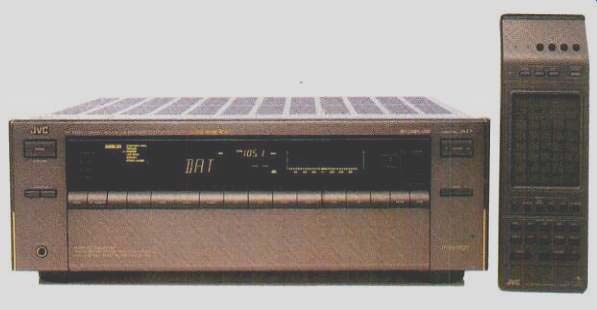
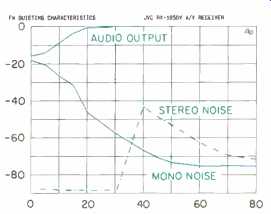
----------FM quieting characteristics, JVC RX-1050VTN.
KENWOOD KR-V9030
In addition to the usual Dolby Pro-Logic surround modes, this receiver offers a choice of six simulated sound environments: "Arena," "Jazz," "Stadium," "Discotheque," "Cathedral," and "Movie Theater." Other features include six DSP sound-field presets, six surround memory presets with name display, a learning remote, automatic input balance for Dolby Surround, two VCR input/output loops and a front-panel video input, S-video connections, video dubbing facilities, 20 tuner presets, and a station name preset system visible on the front-panel display.
Although the Kenwood is rated at 130 watts per channel at 0.03% THD for stereo, this power rating changes to 75 watts per channel (at a maximum of 0.9% THD) when operated in the five-channel surround mode.
Still, I found that the power output in surround was more than adequate, even when driving my relatively inefficient KEF 105.2 speakers as the main pair in a five-channel setup. A built-in test-tone generator simplified level setting for surround and center channels in the Dolby Surround mode.
The Kenwood's FM tuner performance ranked with the best of the seven receivers tested; its 50-dB quieting sensitivity was actually better than specified. I could find only two minor faults with the FM section: First, its relatively low alternate-channel selectivity (55 dB) could be a problem in metropolitan areas where FM stations are closely spaced on the dial. In my tests (some 18 miles from major transmitter sites) no such problems arose. A second minor fault was the FM frequency response, which was down a bit more than 3 dB at 15 kHz.
The 39-page owner's manual was one of the best I encountered during this project.
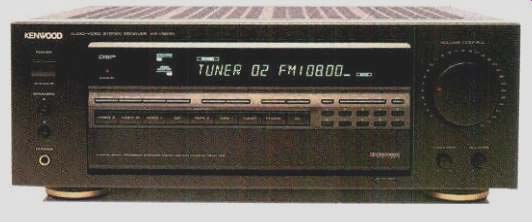
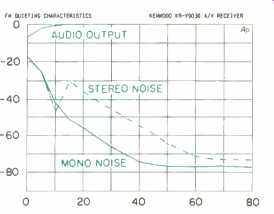
------FM quieting characteristics, Kenwood KR-V9030.
Connection diagrams are very clear, and more important, instructions for each of the many operating modes are presented in a numbered, step-by-step format that will be easy to follow even by those who have never operated an A/V receiver. At a suggested price of $979 including its learning remote, the Kenwood KR-V9030 represents extremely good value compared with some of the tested units; I took this fact into account in my overall rating.
ONKYO TX-SV909PRO
The Onkyo has a fully digital Dolby Pro Logic surround decoder plus seven discrete channels of amplification. It also has the ability to play different programs in two rooms or zones of your house, control menus that display on your TV screen (including diagrams of simulated sound fields and your imaginary seat positions within those fields), and a wealth of other features. Pro-Logic is just one of eight surround and sound-field settings that can create an almost infinite range of audio environments. These include more than the usual number of sound fields (such as two "Theater" and "Hall" settings instead of just one) plus full decoding of Ambisonic encoded source material. Many feel that Ambisonics offers a superior three-dimensional sound experience, and a number of recordings (including the entire Nimbus catalog) have been made with it. As far as I've been able to determine, this is the first and only receiver to incorporate an Ambisonic decoder.
The Onkyo boasts six video inputs and three video outputs, all with composite and S-video connections, plus five audio inputs, an optical digital input, and five audio line outputs. Users can adjust nearly all tuner arid amplifier parameters by using easy-to-follow on-screen menus in combination with the remote control. Other tuning facilities include 40 random station presets (with the ability to assign and scan stations by any of six program-format categories) and the ability to enter station frequencies directly from a 10-key pad. Onkyo's Remote Interactive (RI) system can be used to link the TX SV909PRO to other Onkyo components for control by the receiver's remote. Considering this unit's versatility, its price of $1,795 seems reasonable.
Setting up the TX-SV909PRO for a full home theater installation may likely take you quite a while, as it did me. But if you follow the diagrams and instructions provided in the well-written 45-page owner's manual, you should have no trouble. One unusual aspect of the surround setup is that the Onkyo provides for an extra pair of enhancement speakers, to be mounted somewhat behind and above the usual left and right front speakers. (This is why the Onkyo has seven output channels instead of the usual four or five.) If you can afford the extra pair of speakers for this configuration, by all means include them; they can add a sense of sonic space that you just can't achieve with four or five speakers.
Once setup was complete, I found that I preferred operating the Onkyo from thecom ort of my listening and viewing position in stead of trying to adjust all the parameters via the front-panel controls. Watching a movie on LaserDisc, with Dolby Surround augmented by a receiver such as this Onkyo do-it-all unit, brings me as close to the actual movie theater experience as any set up I've evaluated to date. But don't overlook the fact that as a straight stereo receiver, the TX-SV909PRO offers unsurpassed performance. Onkyo has always been noted for superb FM tuner designs, and they have obviously incorporated much of what they've learned from designing separate tuners into this outstanding receiver. I listened to CDs and to FM radio in the stereo mode (disabling the surround features) and then switched to one of the surround modes. I was always able to find at least one surround mode that was appropriate for the kind of program material I was listening to. But whether you prefer straight stereo or surround sound for music-only listening, it would be hard to beat the performance of this top-of-the-line receiver from Onkyo.
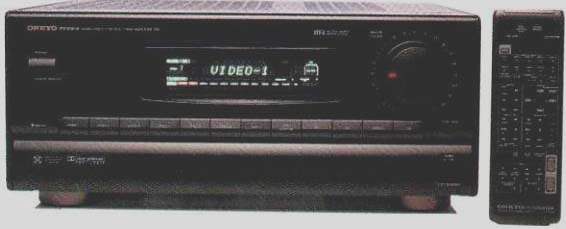
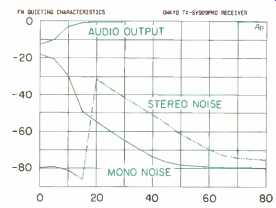
--- FM quieting characteristics, Onkyo TX-SV909PRO.
PIONEER VSX-D901S
A digital signal processing circuit in the VSX-D901S creates five listening environments in addition to the usual Dolby Pro-Logic. Separate audio and video programs can be fed to two different rooms or zones of the house, and with an optional infrared adaptor, the system can be controlled from any room in the house as well.
Any two user-defined control settings (such as input selection, surround mode, or volume) can be stored in memory for instant recall when the "Auto Source Control" button is pushed. For example, you can set the just the volume to your preferred level when the button is pushed; if the CD player is a Pioneer model that shares System Remote (SR) connections with this receiver, it will then start playing. The thumb-indented "Jog" dial is used for a variety of functions:
Tuning, scanning a character table to spell out the names of preset stations, changing surround delay time or total sound-field effect, and adjusting a built-in video enhancer.
A split-screen video display mode lets you adjust the video enhancer while comparing enhanced and normal versions of the picture on one screen. And, like most of the receivers in this review, the Pioneer can show its operating status on your TV screen as well as on its own display.
Tuner facilities include direct-access tuning from a numeric keypad and "Custom Memory" tuning by any of five program categories. The tuner's 50-dB mono quieting sensitivity was extremely good-as was its capture ratio, a characteristic that should make the tuner section especially effective in crowded signal areas and in the presence of multipath reflections. Channel separation was excellent as well, though I did notice a 0.75-dB imbalance between left and right outputs in the mono mode. This may be a function of my particular sample, and of course, it can be corrected by offsetting the balance control slightly. The Pioneer's price of $1,140 falls in the middle of this test group. Considering its features, control functions, and effective surround performance, the VSX-D901S is well worth serious consideration.
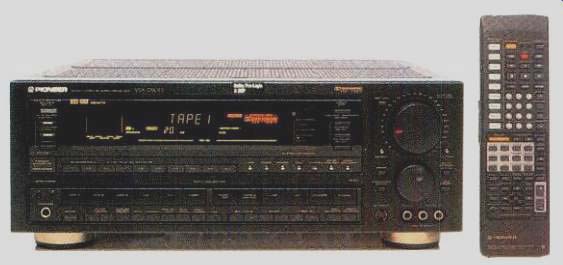
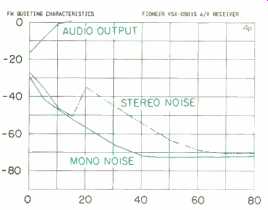
----- FM quieting characteristics, Pioneer VSX-D901S.
SANSUI RZ-9500AV
This A/V receiver delivers enough power to handle some of the more inefficient loud speaker systems around. On a continuous power output basis, its front-channel amps delivered considerably more power than the 100 watts per channel specified by Sansui.
Surround (rear) and center-channel amplifiers easily met their conservatively stated ratings of 30 watts per channel and 40 watts, respectively. FM tuner usable sensitivity was excellent--as good as that of the most sensitive separate tuners.
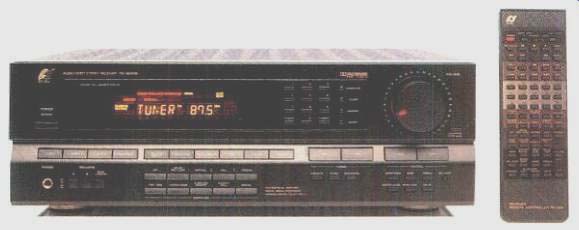
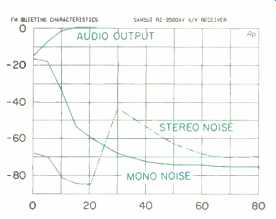
---FM quieting characteristics, Sansui RZ-9500AV.
The RZ-9500AV is supplied with a universal remote control, i.e., it can be taught the codes or commands of other components (including those from other manufacturers).
When not listening to one of the Sansui's many surround sound options, you can choose the "Source Direct" mode, which by passes tone controls and surround circuitry for the shortest signal path between the pro gram source and your main loudspeakers.
You can tailor and store all the parameters of up to four surround settings in memory.
The unit can simultaneously drive a set of front, center, and surround speakers in one room and a stereo pair in another room. Up to 30 AM and FM stations can be preset, and a scan function lets you listen to each memorized station for about 8 S until you select one for listening. Station call letters can also be stored in memory.
A clever arrangement of pushbuttons minimizes the clutter that might have resulted if all switching functions were operated by individual rotary or pushbutton controls. In stead, a single pair of "up" and "down" but tons operates such functions as bass and treble, balance, center- and rear-channel levels, and even rear-channel time delay.
Secondary buttons select which function the up/down buttons perform.
Detailed instructions are a bit sparse in the Sansui owner's manual, but there's enough information to enable a relatively inexperienced user to hook up the unit properly and to take advantage of its versatility. At its suggested price of $769.95, the Sansui is the least expensive receiver I tested. As such, it represents a bargain for those who cannot afford or don't want all the frills (such as DSP and digital Dolby decoding) found in the more expensive units.
SONY STR-GX99ES
Sony has borrowed much of the technology of their successful digital preamp of two years ago, the TA-E1000ESD, in configuring this top-of-the-line A/V receiver. The unit even borrows the TA-E1000ESD's digital compander, to compress CD signals for dubbing to cassette or for background listening, and to expand the dynamics of older recordings. The number of adjustable parameters in Dolby Surround and in the nine additional surround modes is truly awesome.
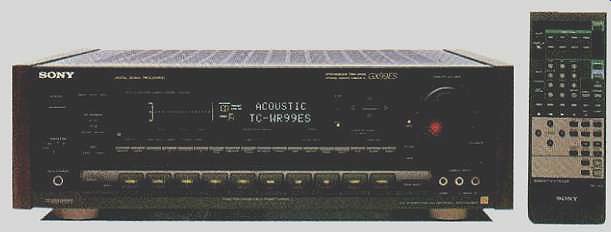
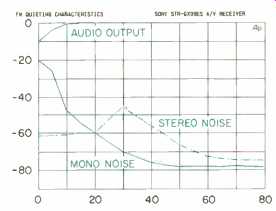
---FM quieting characteristics, Sony STR-GX99ES.
The receiver's programmable remote control can set such parameters of the digitally simulated listening environment as room size, wall material, and seat position as well as such traditional surround parameters as effects level, reverberation time, rear-channel levels, and center-channel level. Add to that the presence of a three-band parametric equalizer, and it becomes clear that the STR GX99ES lets you customize your listening preferences to a greater degree than any of the other models evaluated.
Of course, with such versatility comes a certain amount of complexity. To make operation easier, the status of all the main, DSP, and surround functions and sub-parameters mentioned above can be displayed on the screen of a TV set-right down to the position of the listener's seat in the simulated concert hall. A host of other on-screen graphics makes the detailed DSP adjustments completely clear to the novice user.
The surround sound and Dolby Surround reproduction were superb, especially when I took the trouble to customize all the adjust able parameters and sub-parameters of this remarkable receiver. Despite the number of features and controls that contribute to the Sony's versatility, I found I was able to use all of them after about an hour or so of experimenting with the front panel and the remote control.
As for FM tuner performance, mono 50-dB quieting sensitivity was narrowly better than that of all the other receivers, beating out the nearest competitors by a fraction of a dBf.
Frequency response of the STR-GX99ES was down by nearly 3 dB at 15 kHz, how ever, and distortion was somewhat higher than I would have expected from such an otherwise superb receiver.
The amplifier channels (main, center, and surround) all performed well, exceeding published power and distortion specifications by a relatively wide margin. Like most of the receivers in this group, it had only three video inputs, including the front-panel input usually used for camcorders. I think that more would have been desirable. Many people's home theater installations include at least two VCRs (for editing and dubbing) as well as a LaserDisc player, so at least one more set of video input/output jacks would have been useful. It would also have been nice if Sony had incorporated S-video connectors for the video inputs and outputs, as the makers of most of the competing receivers did.
Still, the magnificent ergonomics, the on screen displays that make adjustments easy to perform, the universal remote control, and the number of possible adjustments with DSP circuitry far outweigh the minor omissions cited. In terms of price, the STIR GX99ES, at $1,000, lands about in the middle of the receivers tested. In terms of surround features, it surpasses all of them.
WINNERS AND RUNNERS-UP
Let me say right off, there are no losers here. All of these receivers have a lot to offer those novices about to enter the world of home theater as well as those trading up from more basic A/V systems. The rankings shown in the accompanying Tables reflect my personal preferences as well as my lab measurements. Readers with different preferences can use the data in the Tables to as sign their own ratings.
After considering all factors (tuner performance, amplifier performance, video performance, convenience features, and price), I find two receivers tie for first-place honors:
The Onkyo TX-SV909PRO (with superb tuner performance, powerful center-channel and front-channel amplifiers, plus those extra front-enhancement amplification channels) and the Sony STR-GX99ES (with superb surround capabilities, helpful on-screen graphics, and an almost infinite number of DSP parameter adjustments). Had the Sony offered slightly better FM frequency response, more video inputs, and some S-video inputs and outputs, it would have been the outright winner in this contest. Had the price of the Onkyo been as low as that of the Sony model, it would have beaten the Sony by some tenths of a rating point. As matters stand, my over- all rating for both the Onkyo and Sony receivers is an outstanding 9.5, on a scale of 0 to 10. (Nothing is perfect!) Close behind were the receivers offered by Denon, Pioneer, and Sansui. While the Sansui lacks some of the features and enhancements of the other two receivers that earned 9.0 ratings, its "bargain" price of $769.95 (lowest of all the receivers tested) earns it extra points in the overall rating. The Kenwood earned an overall rating of 8.8, trailing behind the runners-up by a very small amount largely be cause I found its controls rather complex and difficult to use and because of the higher than expected distortion spec of its important center-channel amplifier. With the features the JVC offers, and with its ratings for amplifier, video, and convenience right up there (at 9.0) with some of the higher ranked models, only its high price and less than stellar FM tuner sensitivity prompted me to assign it an overall rating of 8.0.
FM TUNER SECTION
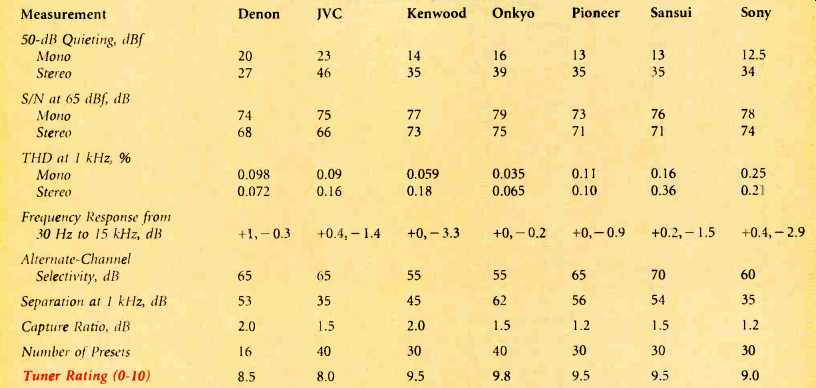
AMPLIFIER SECTION
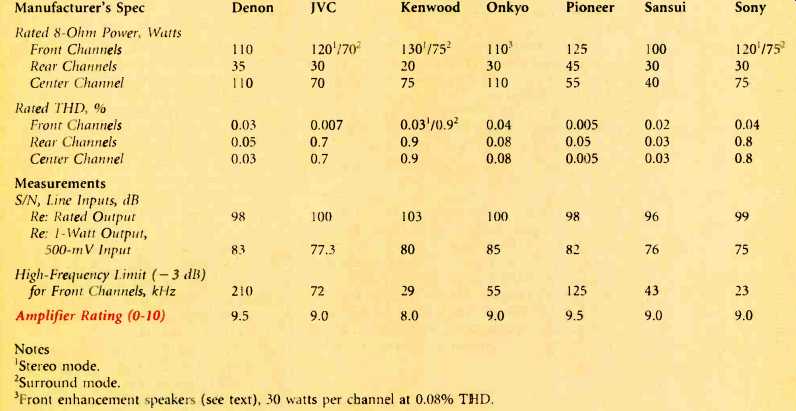
VIDEO SECTION

CONVENIENCE FEATURES
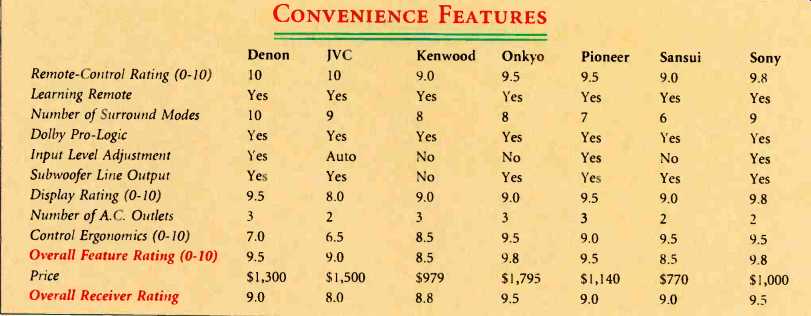
COMPANY ADDRESSES
Denon, 222 New Rd., Parsippany, N.J. 07054.
JVC, 41 Slater Dr., Elmwood Park, N.J. 07407.
Kenwood, P.O. Box 22745, Long Beach, Cal. 90801.
Onkyo, 200 Williams Dr., Ramsey, N.J. 07446.
Pioneer, P.O. Box 1540, Long Beach, Cal. 90301.
Sansui, P.O. Box 1909, Edison, N.J. 08819.
Sony ES, Sony Dr., Park Ridge, N.J. 07656.
(adapted from Audio magazine, Dec. 1992)
Also see:
Battle of the Titans—Two high-power receivers tested (Jan. 1977)
= = = =